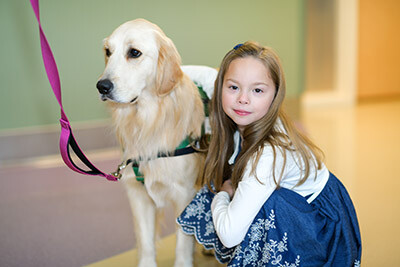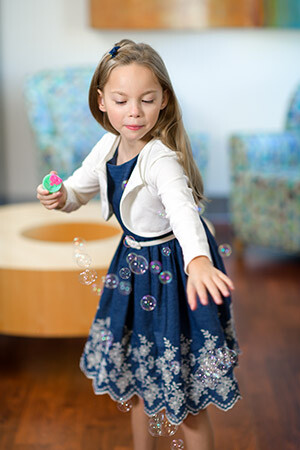
Amelia
When an MRI showed she might never walk without braces, her care team took it as a challenge.
Amelia wants to be a doctor when she grows up. She wants to help people with illnesses and diseases, just like her physicians and nurses at Children’s Health℠ have helped her since she was a baby.
But first? She wants to play more soccer and explore nature a bit. Those are exciting plans for a 9-year-old who was diagnosed with cerebral palsy and told she would struggle to be physically active.
From Emergent to Energetic
Amelia was 4 months old when her now adoptive mother, Robin, met her. She’d spent the first 11 weeks of her life in a local NICU because she was born prematurely.

The baby wasn’t the first child for Robin and her husband, Henk, to adopt or foster. But a note from Amelia’s birth mom worried Robin.
“It said that sometimes when Amelia ate, she stopped breathing,” Robin said.
Within 24 hours, Robin was on the phone with Elsa Alexander, RN, Clinical Coordinator at the Rees-Jones Center for Foster Care Excellence at Children's Health.
As Robin described Amelia's respiratory and feeding issues, Elsa recognized that something was drastically wrong. Robin soon received a call back from a physician at the foster care clinic who told her to bring Amelia to the emergency room (ER) as soon as she could.
Robin said the family didn’t know it at the time, but that intervention is what saved Amelia’s life.
I’m at a loss for words to try and explain the gratitude that we feel for the care she got, which was only made possible because of donors who recognized that there was a need in this particular case, that need had a name. And she’s as beautiful as she is today – and she’s alive today – because somebody stepped up to support the foster care clinic.
— Robin, Amelia's mother
Guided by the attentive care at the foster care clinic in conjunction with her local NICU, Robin and Henk discovered that Amelia had patent ductus arteriosus (PDA), an opening in her heart that needed to be repaired quickly.
Days later, she underwent successful heart surgery.

Although her heart issues were resolved, she struggled, missing milestones. Even the support of early interventions, including speech, feeding and occupational therapies, was insufficient to get Amelia back on track.
That’s when Sara Moore, DNP, a pediatric nurse practitioner who worked with Amelia in the Rees-Jones Foster clinic throughout her journey, began to suspect something neurological.
Sara’s continuous care and intuition were correct. At 22 months, Amelia was diagnosed with cerebral palsy.
The diagnosis meant Amelia might never play sports or dance in a recital. She could struggle with mobility for the rest of her life.
Cerebral palsy is one of the most common motor disabilities in childhood, according to the Centers for Disease Control. This neurological disorder can manifest in many ways, including jerky movements, spasms or shaking.
For Amelia, physical milestones were harder to reach – sitting up, crawling and walking were all difficult for her. Leg and arm braces helped her with normal mobility but held her back from running, jumping, climbing stairs and enjoying activities like other children her age.
Luckily, Amelia had the support of a team of doctors and therapists who didn’t accept her diagnosis as final. Instead, they saw it as a challenge. They treated her symptoms at the root, using early intervention to retrain her brain and body to work as one.
We used to have Children’s Health team members who specialized in occupation therapy, physical therapy and speech therapy come to the house, it was intensive therapy to get her to be able to use her left leg and her left arm. When I look back at videos from that time and look at her now, she is a poster girl for what early intervention does for children.
— Robin, Amelia's mother
Donors Drive Healthy Outcomes
Last year, Amelia’s orthopedic doctor graduated her from care. While she will always have cerebral palsy, the continuity of care and persistence that she received from her care team rewrote Amelia’s story.
Now, Amelia walks without leg braces and is exploring her new favorite hobby – kicking a soccer ball. She doesn’t look like her original MRI scan.

Robin said Amelia’s success is completely due to the continuous care of the team of clinicians at Children’s Health and the foster care clinic. Not only do they offer advanced care for complex medical cases like Amelia’s, but they create a continuity of care for their families.
“The biggest reason for that is having a really great team of doctors, nurses and therapists circled around her. They made sure she got anything she needed,” Robin said. “Even today, when I walk through Children's Health, and I'm stressed, concerned or worried, I exhale because I know I'm in a place where, if we don't already know the answer, we're going to find the answer.”
But without donor support, that continuity of care would be out of reach for most children.
“We have insurance, but that doesn't always cover the full cost,” Robin said. “Without donors, the hospital couldn't be financially solvent. Most people don't realize that donations support their daily existence.”
Like her mom, Amelia is an advocate for Children’s Health – she views her doctors and therapists as her friends and knows that funding is the key to supporting their efforts. More than anything, Amelia wants other children to have the care they need.
“They take care of me, so they’re like family, too,” Amelia said. “If people didn’t donate, Children’s Health wouldn’t be here to help so many people.”
Meet more Children's Health patients
Read more patient stories like Amelia's and meet our Patient Ambassadors to learn how Children's Health makes life better for children.
Kids count on us. We count on you.
Give to support innovative research, lifesaving treatments and compassionate care.
Did you enjoy this story?
If you would like to receive an email when new stories like this one are posted to our website, please complete the form below. We won't share your information, and you can unsubscribe any time.

